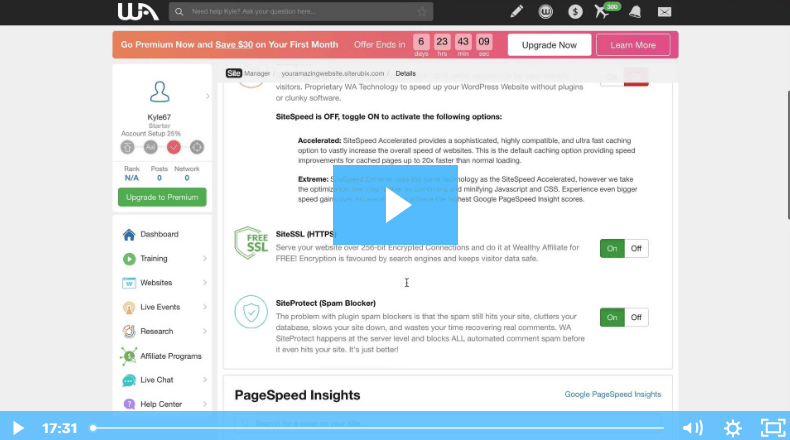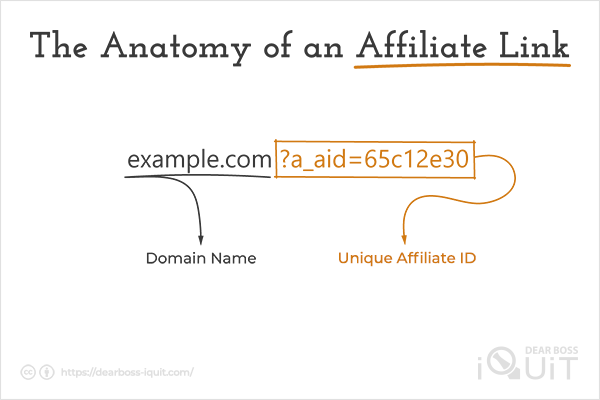Let me guess…
You’ve been searching for a legit way to build a revenue stream online for a while now.
However, you still have nothing to show for all your efforts.
Recently, you stumbled upon an online business model called “affiliate marketing.”
The concept surely caught your attention. However, you’re still not quite sure what it is, how it works, and whether you should give it a try or not.
If so, then you couldn’t have landed in a better place.
In this article, I’ll be addressing every single question you might have about affiliate marketing, such as:
- What is affiliate marketing?
- How does affiliate marketing work?
- How much money can I make with affiliate marketing?
- & more
Without further ado, let’s get started!
What is affiliate marketing?
Affiliate marketing is a performance-based digital marketing model in which you receive commissions for referring paying customers to third-party online merchants.
In simpler words, affiliate marketing is the process of earning money by helping businesses make more sales.
Affiliate marketing is a win-win for all the parties involved.
On one hand, online retailers can use affiliate marketing to raise brand awareness, expand their customer base, and increase conversions, sales, and customer engagement for a fraction of what they’d normally spend on traditional marketing channels.
The history of affiliate marketing
The concepts of revenue-sharing and receiving commissions for referring customers predate both affiliate marketing and even the internet itself.
Modern affiliate marketing was pioneered by American entrepreneur and inventor William J. Tobin in 1994, almost four years after the World Wide Web was publicly launched.
It all started in 1989 when Tobin founded a flower shop called “PC Flowers & Gifts” on Trintex (aka Prodigy), an online service that offered access to a range of digital services, including news, shopping, games, stocks, and more. By 1993, PC Flowers & Gifts was bringing in over $6 million per year in sales.
A year later, Tobin launched an official website for PC Flowers & Gifts along with an affiliate program that paid commissions on a per-sale basis which quickly gathered over 2600 affiliate partners.
And this is how online affiliate marketing was born.
In 2000, Tobin was rightfully granted a U.S. patent for affiliate marketing.
By that time, affiliate marketing had already been implemented by dozens of other large corporations, like Amazon, which was actually one of the first ones to launch an affiliate program as early as 1996.
Amazon’s affiliate program (aka Amazon Associates), swiftly grew to become the most popular affiliate program in the world and according to statistics, by 2013, it was responsible for over 40% of Amazon’s total global revenue.
Therefore, it’s perfectly safe to assume that if Amazon hadn’t launched Amazon Associates, it might have never become the colossus it is today.
Over the next few years, affiliate marketing’s popularity skyrocketed.
Affiliate marketing is currently being used by more than 80% of brands around the world, including some of the most well-established ones, such as:
- Apple
- Nike
- eBay
- AliExpress
- Samsung
- & more
Based on statistics, the value of the affiliate marketing industry is growing at an average rate of 10% per year and is expected to surpass $30 billion by 2025.
This places affiliate marketing among the fastest-growing online business models out there.
How does affiliate marketing work?
Affiliate marketing comes into being through the collaborative efforts of three primary players – the merchant, the customer, and the affiliate.
1. Merchant
The merchant (aka advertiser, retailer, or vendor) is any company or individual running an affiliate program that pays commissions for referring business to them.
Merchants can be as big as corporations like Samsung and Amazon or as small as solopreneurs who sell affiliate marketing courses like Matt Diggity and Doug Cunnington.
2. Customer
A customer is any entity facing a problem that can be solved by purchasing a merchant’s products or services.
Customers are the bread and butter of any business regardless of what industry it’s in or what kinds of products it sells. Any business that doesn’t draw a healthy amount of customers is doomed to eventually fail.
This is exactly where you, the affiliate, come into play.
3. Affiliate
Your primary job as an affiliate marketer is as straightforward as helping merchants acquire more customers by promoting their products or services on various digital marketing channels, such as:
- social media
- paid advertising
- email campaigns
- YouTube
- blogging
- search engine optimization (SEO)
- podcasts
- etc.
Every time you refer a customer to a merchant you’re affiliated with, you’ll receive a commission.
Most of the time, commissions are calculated as a percentage of the total amount of money the customer paid to the merchant. Commission rates can range anywhere between 1 and 75% depending on the merchant and the type of product or service promoted.
For example, physical products typically yield lower commissions than digital products or services. That’s mainly because the profit margins of physical products are a lot smaller due to their significantly increased development, manufacturing, distribution, and support overhead.
While most merchants pay their affiliates on a per-sale basis (PPS), some might leverage the cost-per-action (CPA) pricing model in which an affiliate gets compensated every time a potential lead completes a specific action, such as:
- submitting a form
- signing up for a trial
- installing an application
- etc.
Here’s an overview of how merchants, customers, and you as an affiliate synergize to form the affiliate marketing process:
- You join a merchant’s affiliate program
- The merchant gives you a unique affiliate link that points to their e-shop
- You start promoting your unique affiliate link online (blog, social media, paid ads, etc.)
- Every time a customer clicks on your unique affiliate link and makes a purchase on the merchant’s e-shop, the merchant pays you a commission
How much money can you make with affiliate marketing?
The yearly earnings of beginners to affiliate marketing can range from $20,000 at the low end to $50,000 at the high end. Seasoned affiliate marketers can generate anywhere between $100,000 and $500,000+ per year.
According to PayScale, the average annual income for affiliate marketers in the US is approximately $54,000 per year.
Statistics reveal that 13% of affiliates earn more than $75,000 per year. That may seem like a small percentage but it’s actually quite higher than most money-making models out there.
To give you a frame of reference, the percentage of people who make more than $25,000 per year in MLM is only 3%.
Now that you’re aware of the actual numbers, let’s take a closer look at a few of my favorite affiliate marketing success stories.
Examples of successful affiliate marketers
1. Pat Flynn
Pat Flynn ventured into affiliate marketing in 2009 and has since generated more than $3 million in affiliate commissions mostly through his flagship blog smartpassiveincome.com.
Pat used to share monthly income reports that documented the growth of his affiliate business to $100,000 per month over the course of 10 years but unfortunately, they’re not available anymore.
Nonetheless, in the following video, Pat explains how he generated more than $300,000 in affiliate commissions by promoting a single product.
2. Tom Dupuis
Tom Dupuis got started with affiliate marketing in 2011 by launching onlinemediamasters.com, an affiliate blog that covers topics like WordPress, hosting, speed optimization, and SEO.
According to his latest income report, Tom’s blog brought in about $150,000 in affiliate commissions in 2021.
3. Doug Cunnington
Doug Cunnington got into affiliate marketing in 2013 after being inspired by Pat Flynn’s Smart Passive Income (SPI) Podcast.
According to his last income report, by 2017, Doug had built two successful affiliate niche sites – one that was bringing in $70,000 per year and another that generated over $130,000 over the course of 11 months which he then sold for $235,000.
4. Michelle Schroeder-Gardner
Michelle started her first affiliate blog, makingsenseofcents.com, in 2011 as a way to improve her finances and pay off her $38,000 student loan debt.
By 2013, Michelle was making over $100,000 in affiliate commissions. That enabled her to quit her full-time job, ditch the 9-5 rat race, and become her own boss.
According to her last income report, in 2018, Michelle’s blog brought in more than $1.5 million.
At some point, Michelle and her husband sold their house and started traveling across the United States in an RV. Right now, they voyage around the globe on a sailboat.
For additional examples of successful affiliate marketers, make sure to check out my roundup of affiliate marketing success stories.
Why affiliate marketing?
Affiliate marketing comes with multiple benefits, such as:
- Billion-dollar industry
- Low startup & operational costs
- No customer support
- Passive income potential
- Simple to implement
- Time freedom
- Location independence
Let’s take a closer look.
1. Billion-dollar industry
According to Yahoo Finance, affiliate marketing’s global value in 2021 was estimated at $15 billion and is expected to surpass $27 billion by 2027 with an approximate annual growth rate of 10%.
2. Low startup & operational costs
Launching a business involves a lot of upfront and ongoing expenses for product development, marketing, equipment, physical setup, employees, etc.
According to Small Business Trends, the average startup and first-year operational costs of a typical brick-and-mortar business range between $30,000 and $40,000.
However, since affiliate marketers don’t have to spend money on developing products, maintaining stock, shipping orders, establishing and equipping a physical space, or hiring employees, the costs of starting and running an affiliate business are incredibly low.
As a matter of fact, I personally got started with affiliate marketing for less than $100 and I’ve since been running my entire business for no more than just $300 per year.
3. No customer support
Another pretty compelling aspect of affiliate marketing is that you’ll never have to bother with customer support procedures like:
- customer service
- handling complaints
- issuing refunds
- etc.
Your only job as an affiliate marketer is to refer customers to the merchants you’ve partnered with.
Any customer concerns that may arise once you’ve already made a referral are the responsibility of the merchant.
4. Passive income potential
Contrary to a regular job that pays a fixed hourly wage for devoting time and effort to performing certain tasks, affiliate marketing has the potential to bring in ongoing revenue passively from work you’ve already completed once.
For example, most of my current affiliate earnings are generated through content and marketing funnels I created months or even years ago.
Nevertheless, please note that turning affiliate marketing into a source of passive income does involve the upfront investment of substantial amounts of time, effort, and possibly even money in producing and promoting content, setting up marketing funnels, understanding your audience, optimizing your campaigns, etc.
5. Simple to implement
Since affiliate marketing is the process of earning commissions by promoting already existing products developed, manufactured, maintained, stored, shipped, and supported by established third-party merchants, it eliminates the need of dealing with most challenges and responsibilities associated with launching and running a typical business.
That makes affiliate marketing very simple to implement by virtually anyone regardless of age, education, background, work experience, tech-savviness, etc.
As a matter of fact, most current 6-figure affiliate marketers had no previous affiliate-related experience whatsoever when they first ventured into the industry.
6. Time freedom
Another big advantage of affiliate marketing is that it offers time freedom – that’s the ability to have complete control over every aspect of your daily schedule, such as:
- wake-up time
- working hours
- rest breaks
- downtime
- etc.
For example, I currently work on my affiliate business from 15:00 to 19:00. However, sometimes I might have to adjust my schedule to an earlier or later time depending on whether or not I need to prioritize pressing obligations like projects that require immediate attention.
Ultimately, as an affiliate marketer, you’ll get to tailor your working schedule based on your own unique needs, preferences, and circumstances.
7. Location independence
Last, but not least, affiliate marketing grants location independence – that’s the ability to earn your living remotely without having to be tied to a specific physical location.
As long as you have a device with internet access you can work on your affiliate business from anywhere in the world such as your home, a coffee shop, outdoors, or even while traveling around the globe as a digital nomad.
Affiliate marketing cons
Just like everything else, affiliate marketing isn’t all rainbows and butterflies.
It also has its cons, such as:
- Involves a lot of hard work
- Lack of control
- Performance-based
- Kinda saturated
1. Involves a lot of hard work
Despite its simplicity, affiliate marketing isn’t a quick fix to riches.
On the contrary, building a profitable affiliate business involves a steep learning curve, tons of trial and error, and a lot of upfront hard work over a significant timeframe that could spend several months or even years.
2. Lack of control
Since affiliate marketers don’t develop, own, or handle any of the products they endorse, they have no control over neither their quality, pricing, and fulfillment, nor the overall customer experience delivered by the merchants they’re affiliated with.
If you get 200 people to purchase an affiliate product that turns out to be faulty or one of your merchants doesn’t provide effective support to the buyers you refer to them, there’s practically nothing you can do to improve the situation.
This lack of control across the entire order fulfillment process could potentially hurt your credibility and damage the reputation of your entire affiliate business.
3. Performance-based
Your income potential as an affiliate marketer depends on how well you perform in terms of referring paying customers to the affiliate merchants you’ve partnered with.
On the upside, the better your performance, the more affiliate commissions you’ll be earning.
However, poor performance will result in much lower earnings.
4. Kinda saturated
While affiliate marketing isn’t saturated as a whole, there’s undeniably a massive surge of affiliates in almost all high-profit affiliate niches, such as:
- Health, fitness, & weight loss
- Personal finance & making money
- Dating & relationships
- Beauty & fashion
- Technology & gadgets
That’s because the more profitable a niche is, the more aspiring affiliates would naturally try to break into it.
Reaching success in such competitive niches involves investing considerable amounts of time, effort, and money plus coming up with something unique to bring to the table that sets you apart from the hundreds or even thousands of competitors you’ll be going up against.
How to make money with affiliate marketing
The process of making money with affiliate marketing consists of the following four steps:
- Pick a niche
- Launch a blog
- Build an audience
- Promote products
Step 1: Pick a niche
The first step to making money with affiliate marketing is picking a niche.
A niche can be described as the main subject of your affiliate business and it can be pretty much anything, from meditation and fashion to bitcoin and cycling.
The niche you pursue can make or break your success as an affiliate marketer.
To minimize the chances of failing, ensure that the niche you select checks the following boxes:
- Profitable
- No stifling competition
- Evergreen
Moreover, it’s highly suggested that you go for a niche that’s geared towards a subject you’re interested in or, even better, passionate about. That’ll help your business come across as more authentic and trustworthy.
Also, achieving affiliate success involves putting in a lot of hard and consistent effort over a significant timeframe so if you pick something you don’t care about, the likelihood of giving up halfway there increases tremendously.
On the contrary, running an affiliate business around a topic you love can help you sustain your motivation in the long term and stick to your goals until you’ve seen them through.
Step 2: Launch a blog
The next step to earning money with affiliate marketing is launching a blog.
A good way to think of your blog is like a virtual storefront for your affiliate business that, just like a physical storefront, will represent your brand, act as an entrance point for potential customers, and enable your target audience to gather more info about the products or services you endorse.
Launching a blog might sound scary and pricey, but this couldn’t be further from reality.
Thanks to the latest advancements in website-building technologies like WordPress and Wix starting a fully-functional affiliate blog is simpler and more affordable than ever.
The following 17-minute video walks you through the process of creating a live blog in just 30 seconds without spending a single dime.

While running an affiliate blog is the most popular approach to doing affiliate marketing, leveraging another digital marketing channel like YouTube, Instagram, paid ads, a podcast, etc., could yield much better results in certain niches.
For example, a target group of people who’re after learning how to practice yoga will almost definitely find video content of real-life yoga teachers much more helpful and comprehensible than inanimate written instructions.
In such a case, launching a Youtube channel or an Instagram page could keep your audience a lot more satisfied and drive a much higher ROI for your business than building a blog.
Ultimately, before deciding upon the marketing channel you’ll be focusing on, make sure that you do your research, figure out what kind of content would deliver the most value to people in your niche, and tailor your marketing efforts accordingly.
Step 3: Build an audience
The success of any given business is directly proportional to the size and quality of its audience.
The same goes for affiliate marketing.
Since affiliate marketers get paid per sale they refer, lacking an audience means having no one to promote to, making no sales, and therefore, earning no affiliate commissions.
The first step to growing an audience for your affiliate business is producing and publishing content on your blog.
Content comes in many shapes and sizes, such as:
- How-to guides (How to Start a Blog)
- Entertaining (Job Quitting Stories)
- Product reviews (Wealthy Affiliate Review)
- Roundups (Best Affiliate Marketing Courses)
- Informative (Affiliate Marketing Statistics)
Producing content can also help establish yourself as an expert in your field, develop rapport with your target audience, and ultimately convert potential customers to purchase the affiliate products or services you promote.
However, creating just any content will take you nowhere. To ensure optimal reach, appeal, credibility, and conversion rates, every piece of content you publish must:
- be relevant to your chosen niche
- deliver value by educating, entertaining, or solving a problem
Lastly, make sure that all your content is optimized based on the latest SEO trends. SEO, short for Search Engine Optimization, is a set of practices designed to boost the exposure of your content by improving its rankings on search engines like Google, Yahoo, etc.
Typically, a blog starts gaining traction after having at least 25-50 niche-relevant, high-quality, search-engine-optimized articles published on it.
Step 4: Promote products
Once your blog’s in place and your initial content has started attracting attention, it’s time to start monetizing it by promoting niche-relevant products.
The simplest way to find affiliate products to promote is by signing up for affiliate networks, such as:
- ClickBank
- ShareASale
- JVZoo
- Commission Junction
- & FlexOffers
Alternatively, you can locate affiliate programs in your niche by Googling “Best [your niche] affiliate programs”.
If you’d like to promote the products of a specific company, you can either Google “[company’s name] affiliate program” or check the company’s official website for partnership instructions (they’re usually placed at the bottom).
If a company you’d like to partner with doesn’t seem to have an affiliate program available, you can reach out and ask them directly if they’d be willing to compensate you for referring sales to them.
After joining an affiliate program, you’ll be granted access to one or more affiliate links.
An affiliate link is a URL that contains a unique identifier tied to a specific marketer.
For example, the affiliate link of a marketer with the ID “65c12e30“ would look something like this -> “merchant.com/product?a_aid=65c12e30“.

The unique ID in each affiliate link enables merchants to accurately track all sales referred by their affiliates and compensate each with the corresponding amount of commissions.
Affiliate links are the cornerstone of affiliate marketing. Your end goal as an affiliate marketer is to get as many people as possible to click on your affiliate links and purchase products from the e-shops of your affiliate merchants.
Affiliate marketing tips for success
Affiliate marketing might be simple to implement but the process of achieving success as an affiliate marketer can be rather daunting, especially if you’re a complete beginner.
The following tips will help you start off your affiliate journey on the right foot, lay the proper groundwork for the long-term growth of your business, speed up your progress, and maximize the chances of reaching your financial goals.
1. Build an email list
According to Renderforest, 59% of consumers trust and buy products from brands they’re familiar with.
The most effective way to build a sense of trust and familiarity around your brand that’ll, in turn, increase the likelihood of your audience converting and purchasing the products you promote, is by leveraging email marketing.
Despite its old origins, email marketing is still considered the Holy Grail of customer conversion with an ROI (Return On Investment) of up to 4400%.
That’s because, unlike other marketing channels, email marketing enables you to conveniently deliver content directly into your audience’s inbox whenever you want.
On top of that, email marketing allows you to forward personalized messages tailored to specific segments of your email subscribers, further boosting the efficacy of your marketing message and ultimately, your conversion rates.
Here’s a brief overview of how email marketing works:
- Join an email marketing platform (e.g. MailerLite)
- Build a squeeze page
- Create and offer a free lead magnet
- Set up an automated email sequence
- Launch promotional campaigns
Email marketing is an integral part of making money with affiliate marketing. Even just 200 email subscribers could mean the difference between running a thriving affiliate business and earning mere peanuts or even worse, nothing at all.
That’s exactly why most seasoned marketers claim that “The money is in the email list.”
2. Invest in high-quality training
According to an affiliate marketing benchmark report published in 2016 by AffStat, what holds most affiliate marketers back from growing their income is lack of proper training.
While there’s a lot of free info on affiliate marketing all over the internet, most of it is merely junk that’ll just waste your time, set you off course, hinder your progress, and increase your chances of failing.
The best, and probably only, way to ensure that this doesn’t happen is by investing in tried-and-tested expert training.
Some might argue that buying training isn’t essential for reaching affiliate success.
However, that’s bullsh*t.
Venturing into affiliate marketing without guidance is like trying to cross a minefield while blindfolded. You’ll have to spend twice or thrice more time and effort going through trial and error and you’ll be much more likely to get trampled by competitors who’re smart enough to invest in equipping themselves with proven and up-to-date knowledge.
Over the years, I’ve experimented with dozens of different affiliate marketing courses. Here’s a roundup of the best ones I’ve come across so far – The Best Affiliate Marketing Courses.
3. Focus on delivering value
Delivering value and affiliate success go hand in hand.
A decade ago, affiliate marketers could build a fortune by randomly spamming their promotions at every turn. However, those days are long gone.
Over the years, internet users have learned to identify and steer clear of desperate affiliates who care about nothing but making a sale from miles away.
What I’m about to say might sound counterintuitive, but nowadays, the only way to build a profitable and long-lasting affiliate business is by shifting your focus from making money to providing tons of value to your audience.
For the most part, providing value refers to educating about a subject, solving a problem, or entertaining. To give you an example, the article you’re currently reading offers value in the form of in-depth education on the subject of making money with affiliate marketing.
Prioritizing value can increase your trustworthiness, set you apart from competitors, foster customer loyalty, generate more repeat business, and ultimately, skyrocket your affiliate sales.
4. Track, analyze, and optimize
Tracking, analyzing, and optimizing are essential components to properly growing your business and maximizing your affiliate earnings by enabling you to gain insights into exactly how your audience behaves and make data-driven decisions toward serving them better.
For example, if you’ve published 50 pieces of content and your tracked data indicates that 10 of them perform exceptionally well, it’d be wise to focus your efforts on producing similar content. Likewise, if 2 of the 20 affiliate products you endorse sell twice as much, you’d want to prioritize promoting them over the others.
Tracking, analyzing, and optimizing involves setting up systems like Google Analytics, Google Search Console, Ahrefs, Facebook Insights, etc., that enable you to collect, review, and export data on crucial metrics, such as:
- new users
- returning users
- revenue per page
- earnings per click
- conversion rates
- & click-through rates
Guiding your actions according to insights drawn from actual metrics will save you tons of time, effort, and money you could otherwise waste on practices implemented based on inaccurate, ill-advised, and counterproductive guesswork.
Conclusion
Affiliate marketing is the process of earning commissions for promoting already existing products.
The global worth of the affiliate marketing industry was estimated at $15 billion in 2021 and is expected to surpass $27 billion by 2027 and the average affiliate marketer in the US earns approximately $54,000 per year.
Affiliate marketing comes with tons of benefits including low startup and operational costs, no bothering with customer support, passive income potential, and time freedom among others.
On the other hand, it involves a lot of hard work, a lack of control over the products you promote, and a lot of saturation in certain high-profit niches.
Making money with affiliate marketing consists of four simple steps:
- Pick a niche
- Launch a blog
- Build an audience
- Promote products
Leveraging email marketing, setting up proper tracking of your metrics, and investing in high-quality training could significantly expedite your progress and maximize the returns of your efforts.
Lastly, always keep in mind that affiliate marketing is value-driven – making money with it can never be a primary objective, but rather simply a byproduct of delivering value.
Have any questions or need further help getting started with affiliate marketing?
Leave a comment below or drop me a line and I’ll do my best to get back to you as soon as possible.
All the best, and stay safe,
Harry, Founder & Creative Director at dearboss-iquit.com



